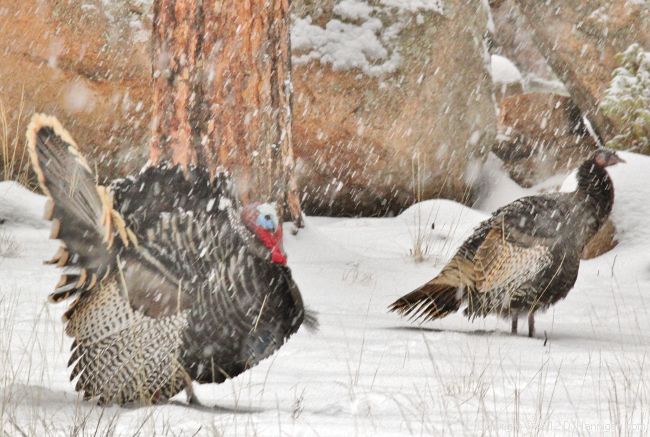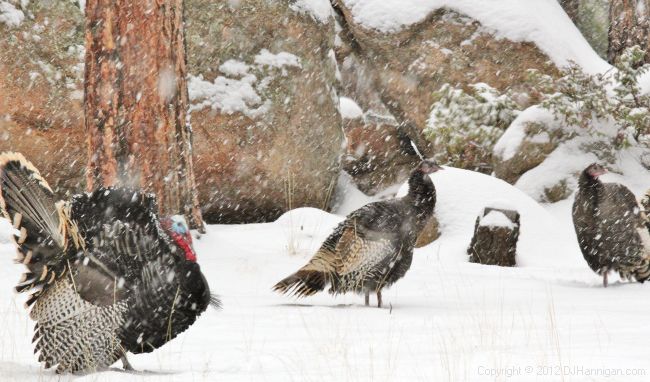Chasing Merriam's
By Jim Bulger, Hunter Outreach Program Coordinator
Seems like the rituals of Spring are beginning a bit early in Colorado this year for our mountain birds. Reports from some of my long-beard chasing friends indicate the Toms are already thinking about romance and the Colorado season is still a few days away. I asked some of my turkey hunting buddies to shoot me a few of their tips on finding Merriam’s here in the foothills and Keith offered up a few hard learned suggestions below. Hope you enjoy the tips and the photos.
Tips From KeithBy Keith Prince, President Front Range Chapter NWTF |
 In the area we hunt, we have found that the flock has several different roost sites they use each night. There are three ridges that all come together and you never know which ridge they will pick at night to roost. We used to guess which ridge they were on and set up in the morning, to find out they roosted on the other ridge. Finally we put our heads together and decided to "know before we go". The night before we hunt, we climb on top of a ridge, right before sunset and settle down. We try and listen for birds that gobble right before fly-up. This helps us pinpoint where they are roosting. If the Toms are quiet, we try and get them to shock gobble for us. This helps us to where to set up the following morning.
In the area we hunt, we have found that the flock has several different roost sites they use each night. There are three ridges that all come together and you never know which ridge they will pick at night to roost. We used to guess which ridge they were on and set up in the morning, to find out they roosted on the other ridge. Finally we put our heads together and decided to "know before we go". The night before we hunt, we climb on top of a ridge, right before sunset and settle down. We try and listen for birds that gobble right before fly-up. This helps us pinpoint where they are roosting. If the Toms are quiet, we try and get them to shock gobble for us. This helps us to where to set up the following morning.
 Mountain birds will typically roost off to one the side of a ridge. They like the large, open branched pines that are 30 to 40 yards downhill from the ridge line. Turkeys need to take a running start before taking flight. We look for open pockets along the ridge that allows birds to group up, strut, stretch their wings and gives them 10 to 15 yards of running room to fly up.
Mountain birds will typically roost off to one the side of a ridge. They like the large, open branched pines that are 30 to 40 yards downhill from the ridge line. Turkeys need to take a running start before taking flight. We look for open pockets along the ridge that allows birds to group up, strut, stretch their wings and gives them 10 to 15 yards of running room to fly up.
Look for small openings that allow for strut zones. In our scouting trips, we found strut zones at the bottom of an old logging road. Typically in the middle of the road, looks like someone had raked all the pine needles away with an old metal yard rake. Not finding too much turkey sign anywhere else, we set up with a couple of hen decoys and starting soft calling. A couple hours later, a Tom walked in. This was towards the end of the season and thinking back, the hens were probably already bred, and the Toms were still wandering around looking for hens. We knew a bird was in the area due to the fresh drag marks in the strut zone. We simply set up, called and waited. He never made a sound. I think he was just making his rounds around his area and came in to check us out. We planned on spending the entire day in the woods, not leaving for lunch, and it paid off.
Choosing a location to set up for calling. I'm a firm believer in choosing natural habitat for my set-ups. Look around for large rocks or thick cover to set up in before calling. One thing to keep in mind is that you can still have a couple of exit routes in case the birds come in from different directions. Also remember not to put natural barriers up in front of you and the birds; creeks or large downed trees. Pick opens that birds can see your decoys or where birds would expect to see each other.

